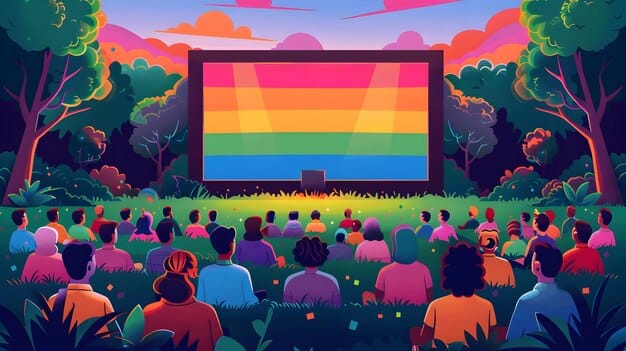Beyond the Stars: Decoding the Language of Movie Reviews

Beyond the Stars: Understanding the Nuances of Movie Review Language explores the unique terminology, critical approaches, and stylistic elements that define professional film criticism, providing insights into how reviewers shape audience perception.
Delving into the realm of cinema requires more than just watching films; it demands understanding the language that shapes our perception of them. Beyond the Stars: Understanding the Nuances of Movie Review Language, therefore, becomes essential for any film enthusiast.
The Anatomy of a Movie Review: Beyond Simple Opinions
Movie reviews are much more than mere expressions of like or dislike; they are carefully constructed pieces of writing that analyze, interpret, and critique the various elements of a film. Understanding their anatomy can enhance our appreciation for both the film and the reviewer’s craft.
Key Components of a Movie Review
A well-crafted movie review typically encompasses several key components, each contributing to the overall assessment of the film.
- Plot Summary: A concise overview of the film’s narrative, setting the stage for the reviewer’s analysis.
- Character Analysis: Examination of the characters’ development, motivations, and performances.
- Direction and Cinematography: Evaluation of the director’s vision, the film’s visual style, and technical execution.
- Themes and Symbolism: Interpretation of the underlying themes, messages, and symbolic elements within the film.
By dissecting these elements, a movie review provides a comprehensive perspective on the film, allowing readers to form their own informed opinions.

Understanding Common Movie Review Terms
Movie review language is rife with specific terminology. Learning these terms can help readers better grasp the reviewer’s arguments and insights.
Common Terms Explained
Familiarizing yourself with the vocabulary used in film criticism opens a door to a deeper understanding of the art form.
- Mise-en-scène: The arrangement of everything that appears in the frame – actors, lighting, décor, etc.
- Motif: A recurring element or idea that has symbolic significance in the film.
- Pacing: The speed at which the film’s narrative unfolds.
- Diegetic/Non-Diegetic Sound: Sound that originates from within the film’s world (diegetic) versus sound added for effect (non-diegetic).
These terms provide a shorthand for discussing complex aspects of filmmaking, allowing reviewers to communicate their ideas concisely and effectively.
The Role of Subjectivity in Movie Reviews
While movie reviews often strive for objectivity, a degree of subjectivity is inevitable. Understanding how personal preferences and biases can influence a review is crucial.
Reviewers, like all viewers, bring their own experiences, tastes, and perspectives to the table. This subjectivity can manifest in several ways, such as:
- Genre Preferences: A reviewer who dislikes horror films may be less inclined to appreciate a horror movie, regardless of its technical merits.
- Cultural Background: A reviewer’s cultural background can influence their interpretation of a film’s themes and messages.
- Personal Experiences: A reviewer’s life experiences can shape their emotional response to a film.
Recognizing the role of subjectivity doesn’t invalidate a review, but it encourages readers to consider the reviewer’s perspective alongside their own.

Differentiating Descriptive vs. Interpretive Language
Movie reviews employ two primary types of language: descriptive and interpretive. Understanding the distinction between these is essential for critically evaluating a review.
Descriptive language focuses on the objective elements of the film, such as:
- Plot Points: Summarizing the key events in the narrative.
- Visual Elements: Describing the film’s cinematography, editing, and special effects.
- Acting Performances: Identifying the actors and their roles.
Interpretive language, on the other hand, delves into the meaning and significance of these elements, offering:
- Analysis of Themes: Exploring the underlying themes and messages.
- Evaluation of Performances: Assessing the quality of the acting.
- Critique of Direction: Evaluating the director’s vision and execution.
A balanced review effectively blends descriptive and interpretive language, providing both a clear account of the film and a thoughtful analysis of its artistic value.
The Impact of Tone and Style in Movie Criticism
The tone and style of a movie review significantly impact how its message is received. A reviewer’s voice can shape the reader’s perception of the film.
Elements of Tone and Style
Tone and style are critical components of any piece of writing, including movie reviews. The tone conveys the reviewer’s attitude toward the subject matter, while the style reflects their personal voice and approach.
- Formal vs. Informal: A formal tone might employ sophisticated language and a detached perspective, while an informal tone could be more conversational and personal.
- Humorous vs. Serious: A humorous review might use wit and sarcasm to entertain the reader, while a serious review would adopt a more earnest and analytical approach.
- Enthusiastic vs. Cynical: An enthusiastic reviewer might express genuine excitement and admiration for the film, while a cynical reviewer could focus on its flaws and shortcomings.
The most effective reviews are those where the tone and style are carefully chosen to complement the film and the reviewer’s overall message.
The Evolution of Movie Review Language in the Digital Age
The advent of the internet and social media has profoundly transformed the landscape of movie reviews. It’s important to understand how digital platforms have shaped the language of film criticism.
The digital age has brought several key changes to the realm of movie reviews:
- Accessibility: Online platforms have democratized access to reviews, allowing anyone to share their opinions on films.
- Brevity: Social media platforms favor short, concise reviews that can be easily shared and consumed.
- Interactivity: Online reviews often include comment sections, allowing readers to engage with the reviewer and each other.
This digital evolution has led to a more diverse and dynamic landscape of movie reviews, but it has also raised concerns about the quality and credibility of online criticism.
Conclusion
Ultimately, beyond the stars: understanding the nuances of movie review language equips you with the tools to navigate the world of film criticism, interpret reviews critically, and cultivate your own informed perspective on cinema. By appreciating the complexities of the language used to discuss films, you can enhance your enjoyment and understanding of the art form.
| Key Concept | Brief Description |
|---|---|
| 🎬 Review Anatomy | Deconstruction of plot, characters, direction, and themes. |
| 🗣️ Common Terms | Understanding jargon like ‘mise-en-scène’ and ‘diegetic sound’. |
| 🤔 Subjectivity | Acknowledging personal bias influences reviews. |
| 🌐 Digital Impact | Analyzing how accessibility changes reviews and discourse. |
Frequently Asked Questions About Movie Reviewing
▼
A credible review demonstrates knowledge of film techniques, offers a balanced analysis, and supports opinions with evidence from the film, without personal bias.
▼
Reviewers attempt objectivity by focusing on technical aspects, narrative coherence, acting quality, and thematic relevance, rather than pure personal enjoyment.
▼
Yes, older movies often undergo re-evaluation considering their historical context, cultural impact, and influence on subsequent films – focusing on relevance over original reception.
▼
A complex one, ideally involving mutual respect; critics analyze, filmmakers create, but both contribute to film culture, occasionally leading to constructive dialogue or disputes.
▼
Not entirely; reviews influence perception, but box office success also depends on marketing, audience trends, and cultural moments, with surprising differences emerging constantly.
Conclusion
In conclusion, understanding the nuances of movie review language enriches the film-watching experience, fostering critical thinking and informed perspectives on cinema. By appreciating the complexities of the review process and the vocabulary utilized, viewers can engage more deeply with the art of film and the discussions surrounding it.





